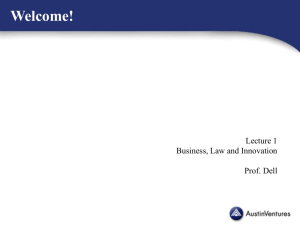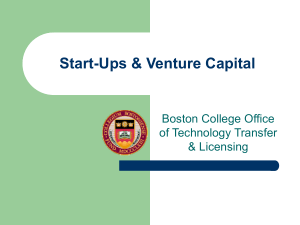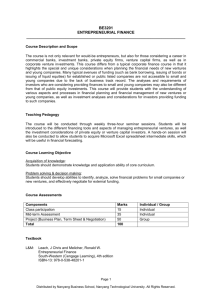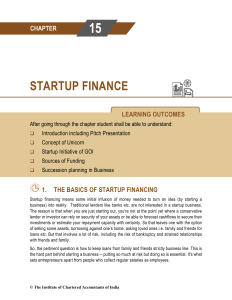Business and Financial Planning
advertisement
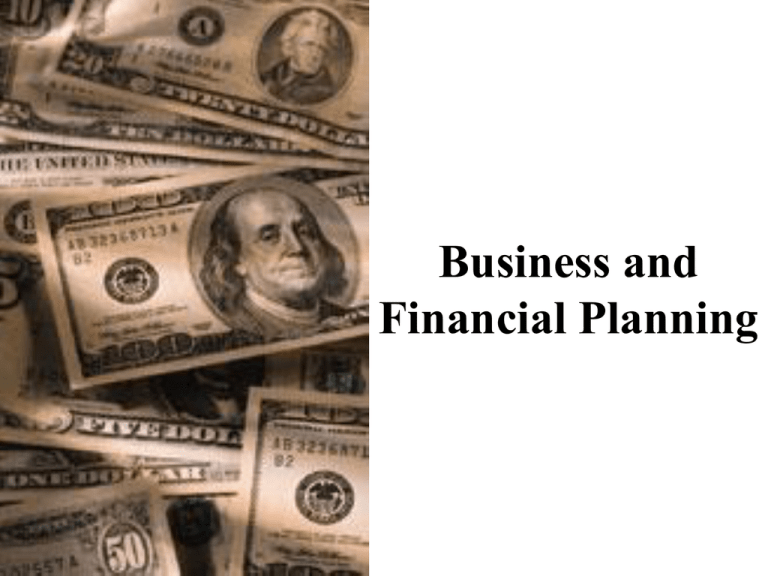
Business and Financial Planning Strategic Project Plan • Business Description – the purpose of the business, the product or service provided, an industry analysis, and the business model. • Market Analysis – a description of the venture’s target consumers, market and key competitors. • Preliminary Financial Plan – cost/benefit analysis, financing required and sources, profit and cash flow projections. Vision and Mission Statements • An overall statement of the business's goals and philosophy • Define your purpose • Know your intended audience A Vision Statement A Mission Statement Products and Services • A description of each product or service you plan to offer • Level of detail is important • Enough for the reader to understand and not be confused Industry Analysis • An analysis of the business environment • Focus on the basic industry segment • Based on verifiable data and market research Business Model • The method by which a firm builds and uses its resources to offer its customers better value than its competitors and to make money doing so! Two major parts of the business model: • Value Proposition • Financial Model Value Proposition • The value your company adds that would make customers switch to you from their current provider. Concepts involved in Value Proposition • Choice of Segments • Choice of Focal Customer Benefits • Choice of Unique and Differentiating Capabilities Value Proposition • Choice of Segments – market size or growth – unmet customer needs – weak or no competition • Choice of Focal Customer Benefits – One or two KEY benefits based on the marketing mix variables – Ex: fast delivery, high quality products, customer service, low-prices, unique product • Choice of Unique and Differentiating Capabilities – Also known as : Core Competencies or Unique Resources – Tangible assets (location), Intangible (Brand name) or corporate skills and capabilities (knowledge of customers) Financial Models • There are four revenue models: – Advertising (sell ads, site sponsorships, interstituals) – Product sales (income from the sales of products, services, or information) – Transaction (revenue from charging a fee or a taking a % of a transaction) – Subscription (subscriber fees for magazines, information, services, …) – Or a combination of these Revenue Model - Advertising Revenue Model – Product Sales Revenue Model – Transaction eBay fee Structure http://pages.ebay.com/help/sellerguide/selling-fees.html Revenue Model – Subscription Marketing Plan • Target market description • Demographic, geographic, and psychographic characteristics of market • Competitive analysis Financial Plan • Shows the reader how all the ideas, concepts and strategies described elsewhere come together in a profitable way. • The plan should include pro forma: – Balance sheet – Income statement – Cash flow statement • Financing required and sources Financial Plan • Balance Sheet – Assests – Liabilities – Equity • Income Statement – Revenues – Cost of Goods Sold = Net Income • Cash Flow Statement – Operating Activities – Investing Activities – Financing Activities Startup Financing • As an entrepreneur starting a new ebusiness, you must be prepared to invest time, effort, and your own money to get your new e-business off the ground. • • • • Personal Assets Friends and Family Venture Capital Business Incubators Personal Assets • Sweat Equity: putting in time and effort • Mortgage Personal Assets: put up property as collateral to a bank • Personal loans: taking a loan without collateral (higher interest rate) • Credit card/credit line advance: similar to a personal loan (usually a high interest rate) Friends and Family • Friends and family investors are family members or friends who invest in a business. • Many entrepreneurs successfully solicit startup money from their network of friends and family. • A network of potential friends and family investors extends beyond immediate family members and friends, to their families and friends, to their families and friends, and so on. Advantage: It might be the easiest money you’ll ever get. Disadvantage: Putting their money at risk. Venture Capital Investors • Venture Capital (VC) firms are organized to invest specifically in new business startups. • Typically take a significant equity interest in the firm with in exchange for providing startup capital. • May also provide expertise. • Typically do not invest for the long term but expect to “cash out” after the business establishes a successful track record and can be sold or acquired by others. • There are many established VC firms Venture Capital Investors Business Incubators • Have traditionally been government- or university-supported nonprofit organizations that nurture new businesses • Provide startup companies with management advice, office space, networking opportunities, and other critical startup services • May take an equity interest as well as charge for services • Not-for-profit incubators may use returns from equity to reinvest http://www.digitalrhine.com/ Commercial Business Incubators • Offer startup e-businesses access to the same services offered by nonprofit incubators • Are primarily interested in high-technology businesses that can become financially viable quickly and leave the incubator within six months to a year



